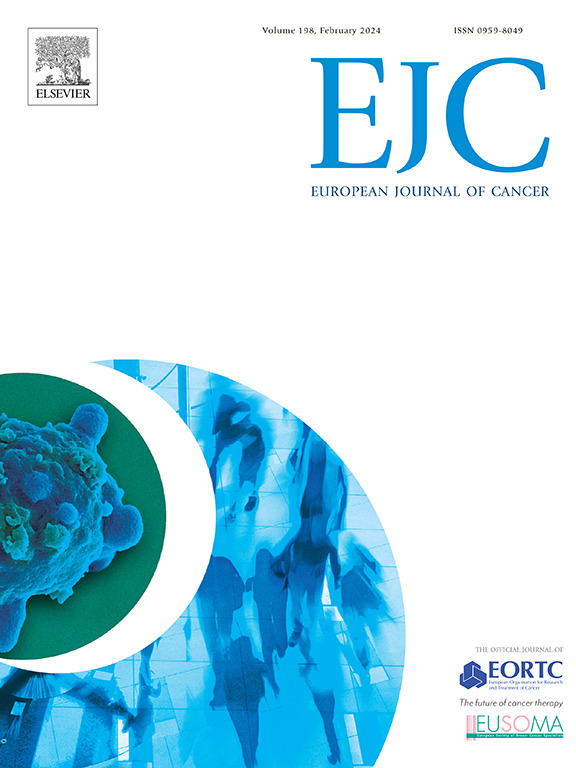使用机器学习预测化疗患者的细菌和真菌血流感染
IF 7.6
1区 医学
Q1 ONCOLOGY
引用次数: 0
摘要
目的建立预测化疗患者血流感染(BSI)的机器学习(ML)模型。患者和方法纳入2017年至2022年在三级肿瘤医院接受化疗的所有癌症患者。收集每个化疗周期的数据,包括化疗药物、适应症、周期数、癌症类型、体重指数、年龄、性别、全血细胞计数、肌酐水平和微生物培养。化疗后21天内评估BSI。所测试的机器学习算法包括逻辑回归、岭回归、k近邻、朴素贝叶斯、感知器、神经网络、决策树、增强方法、随机森林和支持向量机。采用SHapley加性解释(SHAP)方法测量特征重要性。结果在19225例患者的107,757个周期中,91.7% %发生实体肿瘤,主要是乳腺癌(36.8% %)和胃肠道(19.4% %)肿瘤。第一周期占23.7% %,姑息性化疗占52.9% %。烷基化剂是最常用的药物类别(55.5 %)。BSI发生在1.33% %的周期中,其中34 %发生在中性粒细胞减少患者中。菌血症病例中,11.8% %为多微生物,69.3% %为革兰氏阴性菌。最佳模型为一个隐含层(5个神经元)的神经网络,灵敏度为70.7 %,特异性为93.49 %,准确率为93.19 %,受者工作特征曲线下面积为91.93 %。关键预测因素包括第一个周期、抗代谢药物的使用、姑息性化疗、单核细胞减少症和血液系统恶性肿瘤。结论ml可有效预测化疗患者的菌血症,包括非中性粒细胞减少病例,可用于临床指导治疗和感染监测。本文章由计算机程序翻译,如有差异,请以英文原文为准。
Prediction of bacterial and fungal bloodstream infections using machine learning in patients undergoing chemotherapy
Purpose
This study aimed to develop a machine learning (ML) model to predict bloodstream infection (BSI) in chemotherapy patients.
Patients and methods
We included all cancer patients undergoing chemotherapy at a tertiary cancer hospital from 2017 to 2022. Data were collected per chemotherapy cycle, including chemotherapy drugs, indications, cycle number, cancer type, body mass index, age, gender, complete blood count, creatinine levels, and microbial cultures. BSI was assessed within 21 days after chemotherapy. The ML algorithms tested included logistic regression, ridge regression, k-nearest neighbors, Naive Bayes, Perceptron, neural networks, decision trees, boosting methods, Random Forests, and Support Vector Machines. The SHapley Additive exPlanations (SHAP) method was used to measure feature importance.
Results
Among 107,757 cycles from 19,225 patients, 91.7 % had solid tumors, primarily breast (36.8 %) and gastrointestinal (19.4 %) cancers. The first cycle accounted for 23.7 % of cycles, and palliative chemotherapy made up 52.9 %. Alkylating agent was the most common drug class used (55.5 %). BSI occurred in 1.33 % of cycles, with 34 % of these cases occurring in neutropenic patients. Of the bacteremia cases, 11.8 % were polymicrobial, and 69.3 % involved gram-negative bacteria. The best model was a neural network with one hidden layer (5 neurons), achieving 70.7 % sensitivity, 93.49 % specificity, 93.19 % accuracy, and an area under a receiver operating characteristic curve of 91.93 %. Key predictors included the first cycle, antimetabolite use, palliative chemotherapy, monocytopenia, and hematological malignancies.
Conclusion
ML effectively predicts bacteremia in chemotherapy patients, including non-neutropenic cases, and could be used in clinical practice to guide treatment and infection workup.
求助全文
通过发布文献求助,成功后即可免费获取论文全文。
去求助
来源期刊

European Journal of Cancer
医学-肿瘤学
CiteScore
11.50
自引率
4.80%
发文量
953
审稿时长
23 days
期刊介绍:
The European Journal of Cancer (EJC) serves as a comprehensive platform integrating preclinical, digital, translational, and clinical research across the spectrum of cancer. From epidemiology, carcinogenesis, and biology to groundbreaking innovations in cancer treatment and patient care, the journal covers a wide array of topics. We publish original research, reviews, previews, editorial comments, and correspondence, fostering dialogue and advancement in the fight against cancer. Join us in our mission to drive progress and improve outcomes in cancer research and patient care.
 求助内容:
求助内容: 应助结果提醒方式:
应助结果提醒方式:


